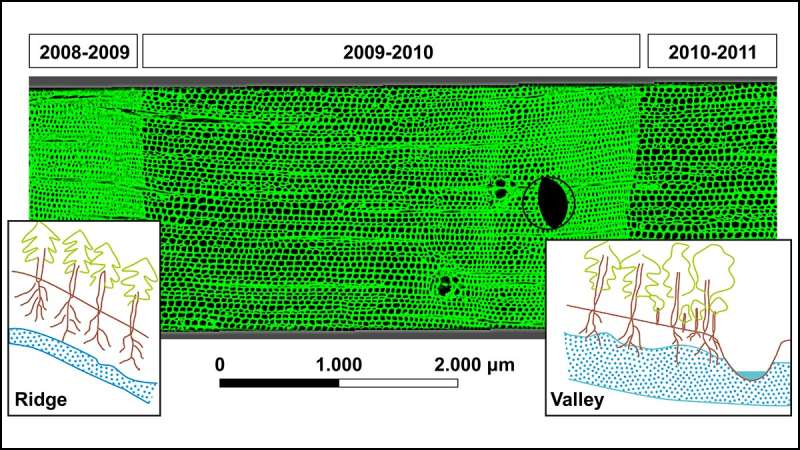Radiata pine (Pinus radiata), seen here under a confocal laser scanning microscope, often produces more than 150 rows of tracheids per growing season, which provides the high temporal resolution needed to study intraseasonal hydrological effects of earthquakes. Insets show low and high groundwater levels along the ridge and the valley bottom. Credit: Christian Mohr
When trying to make sense of past earthquakes, researchers typically turn to the geological record. However, there may be clues to understanding old quakes in the biological record as well—in tree rings, for example. As earthquakes shake Earth's surface, they increase the permeability of soils, potentially shifting the flow of water underground. Previous observations suggest that after a quake, water may gather in valleys and drop along ridges, which could affect tree growth and transpiration, particularly in water-stressed environments.
To test this, Mohr et al. looked at pine forest plantations on the Chilean Coast Range after the Maule earthquake in 2010. The magnitude 8.8 quake increased streamflow and evapotranspiration for at least 10 days. The team used core samples of trees located on the valley floor and the hillslope ridges and looked at highly resolved subseasonal stable isotope ratios of tree rings to understand the growing season conditions—a reflection of the hydrological response to the earthquake. In a first, the authors also considered cell-level wood anatomy, quantifying features of the tree rings, including the lumen area (the space inside the circular tree ring structure), lumen diameter, cell wall thickness, and cell diameter, to understand how the hydrological changes may have affected tree response to the quake in terms of the conductivity of wood for water and tree growth.
Although the impacts were small, the authors conclude that the postseismic changes in water availability did influence tree growth and photosynthesis. The data show that evapotranspiration increased in the valleys and decreased along the ridgelines. Because there was no rainfall in the period leading up to the earthquake, these changes were likely induced by earthquake-triggered changes in water availability.
The authors caution that these kinds of responses are likely to occur only in environments with limited water availability, where earthquakes may provide extra water that relieves water stress. The study shows how a dendrohydrological analysis over the short term (i.e., on the scale of weeks) can pick up on impacts that annual-scale analyses might miss.
More information: Christian H. Mohr et al, Trees Talk Tremor—Wood Anatomy and Content Reveal Contrasting Tree‐Growth Responses to Earthquakes, Journal of Geophysical Research: Biogeosciences (2021). DOI: 10.1029/2021JG006385
Provided by American Geophysical Union
This story is republished courtesy of Eos, hosted by the American Geophysical Union. Read the original story here.























